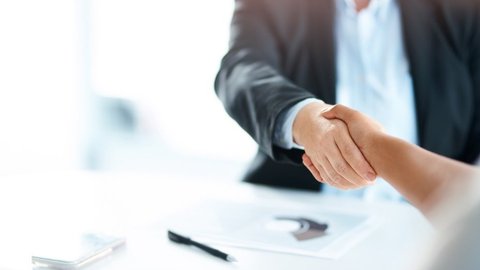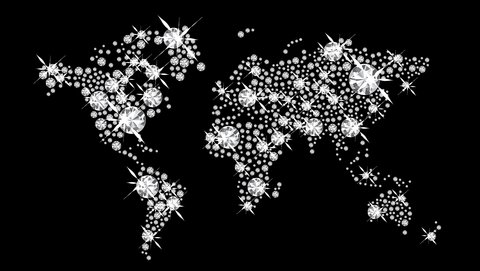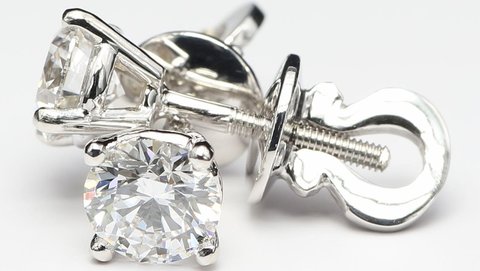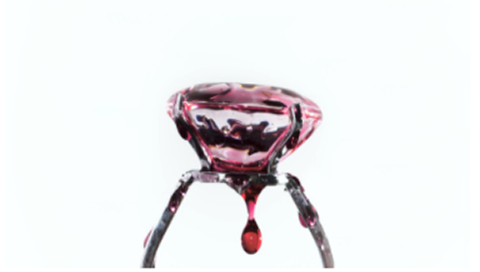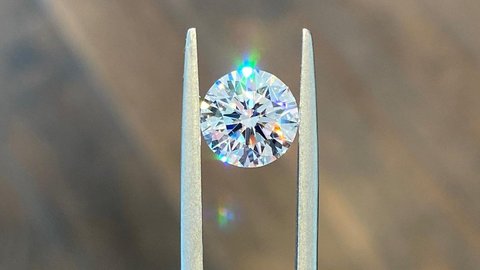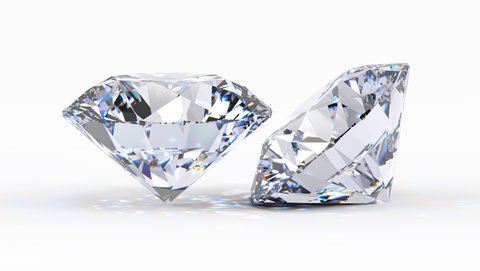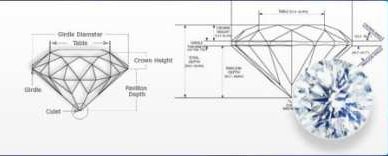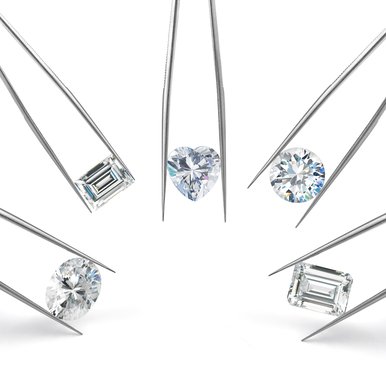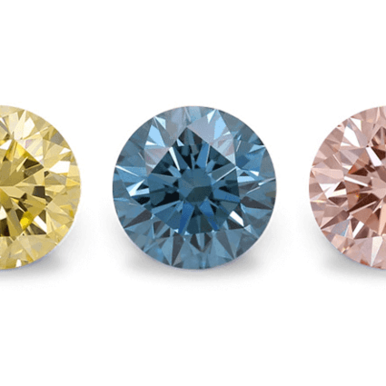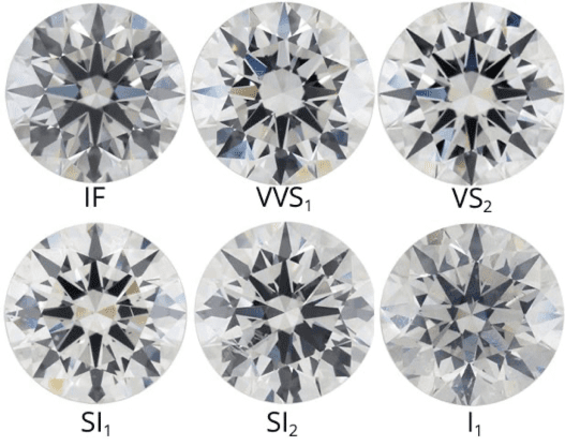
What Clarity means for 4C
As the diamond formation process includes enormous amount of pressure and temperature elevated to thousands degrees, there can be some “inclusions” formed in the structure of the stone made of metals or atom dislocations. The clarity of the diamond depends on the location, amount, size and material of the imperfections. The clearer the diamond seems, the more valuable it is as more light can pass through, creating the sparkle. Heavily included stones, on the other hand, might look plain.
GIA established the following grading criteria of clarity: flawless (FL), internally flawless (IF), very very slightly included (VVS1-VVS2), very slightly included (VS1-VS2), slightly included (SI1-SI2) and included (I1-I3). Flawless and internally flawless diamonds are very pricy, as the inclusions cannot even be noticed with magnification. A better bargain might be an “eye-clean” diamond, which can be graded as SI1 or VS2, though none of the imperfections are visible to a naked eye.
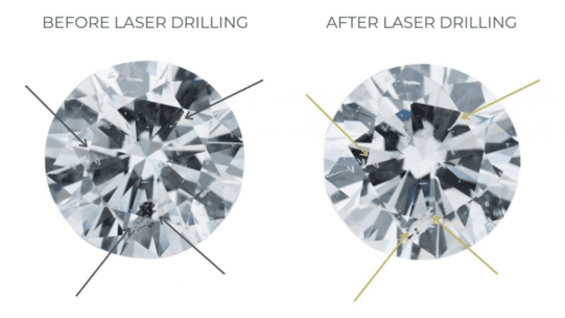
Clarity-enhanced diamonds
The clarity of the diamond can be improved by the means of laser drilling and fracture filling. It means that if there are serious imperfections in the stone that was graded as included (I1-I3) it could be improved by removing the spots with a laser beam. Such treatment can be seen only with a microscope; however it can weaken the diamond's structure. If there are a lot of inclusions removed this way, the stone can be destroyed. Therefore, treated diamonds are less valuable and the treatment should be disclosed to the customer. The same goes for fracture filling: the scratches can be made less seen, although the sparkle can be decreased due to the material used to cover the imperfections.
How to choose diamond clarity?
The most important thing is to choose a diamond which is eye-clean; it might be VS2 or SI1 clarity. It will not cost as much as FL or IF, however if the inclusions are not severe it might be as sparkly depending on the color and cut of the diamond.
The Clarity Advantage: Lab-Grown vs. Natural Diamonds
Lab-grown diamonds offer several distinct advantages when it comes to clarity characteristics compared to their natural counterparts. At Labrilliante, our controlled creation environment allows us to manage certain aspects of the diamond growth process, which can influence clarity outcomes.
Comparison Table: Clarity Characteristics in Natural vs. Lab-Grown Diamonds
| Aspect | Natural Diamonds | Lab-Grown Diamonds (Labrilliante) |
|---|---|---|
| Common Inclusion Types | Mineral crystals, feathers, twinning wisps, knots, naturals | Metallic flux (HPHT), crystal deposits, growth lines (CVD) |
| Inclusion Patterns | Random distribution, often formed over billions of years | More predictable patterns related to specific growth methods |
| Typical Clarity Range | Broad spectrum from I3 to FL, with majority in SI-VS range | More concentrated in higher clarity ranges (VS and above) |
| Identifying Features | Mineral inclusions unique to earth formation | Method-specific inclusions (metallic in HPHT, growth bands in CVD) |
| Typical Color of Inclusions | Black, white, transparent, colored (garnet, olivine) | Metallic reflective (HPHT), dark carbon deposits (CVD) |
| Location of Inclusions | Unpredictable, can appear anywhere in the stone | Often follows growth direction, more systematic |
| Surface Features | Natural crystal faces, abrasion marks, trigons | Generally fewer surface characteristics due to controlled environment |
| Availability of Higher Clarity | Rarer in nature, especially in larger sizes | More readily available across all sizes at Labrilliante |
The Diamond Clarity Scale: Understanding Quality Grades
The internationally recognized diamond clarity scale provides a systematic way to evaluate and communicate a diamond's clarity characteristics. At Labrilliante, we adhere to this standardized grading system to ensure transparency and confidence in your purchase.
Flawless (FL) and Internally Flawless (IF)
The pinnacle of clarity, Flawless diamonds show no inclusions or blemishes under 10x magnification. Internally Flawless diamonds have no internal inclusions but may have minor surface blemishes. At Labrilliante, these exceptional clarity grades represent our highest achievement in diamond creation technology.
Very Very Slightly Included (VVS1 and VVS2)
These diamonds contain extremely minor inclusions that are difficult for even trained gemologists to see under 10x magnification. VVS1 inclusions are typically only visible from the pavilion (bottom), while VVS2 inclusions may be slightly more visible but still require expert examination to locate.
Very Slightly Included (VS1 and VS2)
VS clarity diamonds contain minor inclusions that are somewhat difficult to see under 10x magnification. The difference between VS1 and VS2 relates to the size, number, and position of the inclusions. At Labrilliante, our VS clarity lab diamonds offer exceptional value while remaining visually flawless to the naked eye.
Slightly Included (SI1 and SI2)
SI clarity diamonds have noticeable inclusions under 10x magnification, but many remain invisible to the unaided eye, especially in smaller stones. Labrilliante's SI clarity diamonds are carefully selected to ensure they still deliver excellent brilliance and beauty.
Included (I1, I2, I3)
These diamonds have inclusions visible to the naked eye that may affect transparency and brilliance. While they offer affordability, at Labrilliante we typically recommend higher clarity grades for engagement rings and fine jewelry.
The Creation Process: How Lab Diamonds Form and Develop Clarity Characteristics
At Labrilliante, we utilize cutting-edge technology to create our lab-grown diamonds. Understanding the creation process helps explain why certain clarity characteristics appear in lab diamonds and how they differ from those found in natural stones.
Comparison Table: HPHT and CVD Processes with Clarity Characteristics
| Process Feature | HPHT (High Pressure High Temperature) | CVD (Chemical Vapor Deposition) |
|---|---|---|
| Creation Environment | Diamond seed placed in metal catalyst with carbon source under extreme pressure (1.5+ million PSI) and heat (2,700°F+) | Diamond seed placed in chamber with carbon-rich gas activated by microwave energy |
| Growth Direction | Multi-directional growth from seed crystal | Vertical growth in layers from base seed |
| Growth Speed | Faster formation process | Slower, more controlled layer-by-layer formation |
| Typical Inclusions | • Metallic flux inclusions (silver/gray) • Small diamond crystal inclusions • Pinpoints • Graining patterns | • Dark carbon deposits • Cloud formations • Growth bands/striations • Needles |
| Inclusion Distribution | More random distribution throughout the diamond | Linear or layered patterns following growth direction |
| Inclusion Appearance | Often reflective or semi-transparent | Typically darker or more opaque |
| Detection Methods | • Magnetic testing (for some metallic inclusions) • Cross-hatched strain patterns under polarized light • Metallic pinpoints visible with darkfield illumination | • Linear strain patterns under polarized light • Growth bands visible with diffused illumination • Possible phosphorescence after UV exposure |
| Typical Clarity Advantages | • Better for achieving higher clarity in colorless diamonds • Can produce flawless diamonds more consistently | • Fewer metallic inclusions • Better for fancy colored diamonds • More controlled growth pattern |
| Labrilliante Specialty | Premium colorless diamonds with VS and higher clarity | Larger carat weights with exceptional color consistency |
Comparison Table: HPHT vs. CVD Diamond Clarity Characteristics
| Characteristic | HPHT Diamonds | CVD Diamonds |
|---|---|---|
| Most Common Inclusions | Metallic flux, crystal inclusions | Dark carbon deposits, clouds, growth bands |
| Inclusion Appearance | Generally reflective or transparent | Often darker or opaque |
| Inclusion Pattern | More randomly distributed | Linear or layered patterns following growth direction |
| Typical Color of Inclusions | Silver, gray, sometimes black | Black, dark gray, occasionally white |
| Strain Patterns | Cross-hatched patterns under polarized light | Linear strain patterns under polarized light |
| Fluorescence | Rarely shows strong fluorescence | May show phosphorescence after UV exposure |
| Magnetic Properties | Some inclusions may be magnetic due to metal content | Non-magnetic inclusions |
| Detection under Magnification | Metallic pinpoints visible with darkfield illumination | Growth bands visible with diffused illumination |
| Clarity Advantage | Often achieves higher clarity in colorless diamonds | Better for fancy colored diamonds, fewer metallic inclusions |
Determining Clarity Grades: What Experts Evaluate in Lab-Grown Diamonds
When grading the clarity of lab-grown diamonds at Labrilliante, expert gemologists consider several key factors that collectively determine the final clarity grade. Understanding these factors helps you make an informed choice when selecting your perfect diamond.
Size of Inclusions: The Bigger Factor
The size of inclusions significantly impacts clarity grade. Larger inclusions are more likely to interfere with light performance and may be visible to the naked eye. At Labrilliante, our controlled growing environment helps minimize the size of inclusions, allowing us to consistently produce higher clarity diamonds.
Nature of Inclusions: Not All Are Created Equal
Different types of inclusions impact clarity grades differently:
- Reflective inclusions like crystals may be more noticeable than transparent ones
- Dark inclusions contrast against the diamond's body color and affect grade more significantly
- Inclusions that reach the surface (known as "open") can affect durability and receive lower grades
Labrilliante's lab diamonds often contain different types of inclusions than natural diamonds due to our unique growing processes.
Number of Inclusions: Counting Clarity
The total number of inclusions affects the clarity grade, with fewer inclusions resulting in higher grades. Our cutting-edge technology at Labrilliante allows us to create diamonds with fewer inclusions while maintaining their authentic character.
Location of Inclusions: Position Matters
Inclusions located in the center or table of the diamond (the flat top facet) are more visible and impact the clarity grade more significantly than those hidden near the girdle (edge) or pavilion (bottom). Our expert cutters at Labrilliante strategically plan each diamond's cut to minimize the visibility of any inclusions.
Relief of Inclusions: Contrast and Visibility
Relief refers to how noticeable an inclusion appears against the background of the diamond. High-relief inclusions stand out more prominently and affect the clarity grade more substantially. At Labrilliante, our creation processes help reduce high-relief inclusions, resulting in more beautiful diamonds.
Common Inclusions in Lab-Grown Diamonds: A Visual Guide
At Labrilliante, we believe in complete transparency about our diamonds' characteristics. While our lab-grown diamonds offer exceptional clarity, each stone has its own unique identity. Understanding the different types of inclusions helps you make an informed decision when selecting your perfect diamond.
Common Inclusions in Lab-Grown Diamonds: A Visual Guide
| Inclusion Type | Description | Typical Appearance | Impact on Clarity | Common in |
|---|---|---|---|---|
| Graining | Internal growth lines that appear as faint lines or reflections | Subtle waves or lines visible when tilted | Minimal impact; usually only affects FL/IF grades | Both lab and natural diamonds |
| Feather | Small fractures within the diamond | Transparent, feather-like appearance | Varies widely depending on size and location; can impact durability if large | More common in natural diamonds |
| Cavity | Small opening on the surface that extends into the diamond | Irregular depression or hollow | Moderate to significant depending on size; affects polish | Both lab and natural diamonds |
| Bearding | Fine, hair-like lines radiating from the girdle | Fuzzy appearance around the diamond's edge | Minor impact unless extensive | More common in poorly cut diamonds |
| Cloud | Cluster of tiny, closely grouped inclusions | Hazy or foggy area in the diamond | Can significantly impact brilliance if large or dense | Common in CVD lab diamonds |
| Crystal | Mineral crystals trapped within the diamond | Small, geometric shapes inside the diamond | Varies based on color, size, and location | HPHT lab diamonds (often metallic) |
| Pinpoint | Extremely small crystals that appear as dots | Tiny dots visible only under magnification | Minor impact unless clustered in clouds | Common in lab-grown diamonds |
| Needle | Long, thin crystal inclusions | Slender, rod-like formations | Usually minimal impact unless large or numerous | More common in CVD lab diamonds |

Finding Your Perfect Clarity: How to Choose the Right Grade for Your Budget
Selecting the ideal clarity grade for your lab-grown diamond involves balancing visual appeal, value, and budget considerations. At Labrilliante, we guide you through this decision process with expert advice tailored to your specific needs.
The "Eye-Clean" Standard: What Really Matters
An "eye-clean" diamond appears flawless to the naked eye, regardless of its technical clarity grade. Many VS2, SI1, and even some SI2 clarity diamonds from Labrilliante appear completely clean without magnification, offering exceptional value without compromising on beauty.
For most diamond sizes under 1 carat, VS2 and better diamonds will appear flawless to the naked eye. For larger stones (1-2 carats), we typically recommend VS1 or better, as inclusions become more visible with increased size. Diamonds above 2 carats benefit from VVS2 clarity or higher to ensure they appear flawless.
Balancing Your Budget: The Clarity Sweet Spot
At Labrilliante, we've identified clarity "sweet spots" that offer the best value for different diamond sizes:
- For diamonds under 1 carat: SI1 to VS2 often provides the perfect balance
- For 1-2 carat diamonds: VS2 to VS1 typically offers the best value
- For diamonds above 2 carats: VVS2 often represents the ideal intersection of quality and value
Diamond Shape Considerations
The diamond's shape affects how visible inclusions become:
- Round, oval, and cushion cuts tend to hide inclusions better
- Emerald, asscher, and radiant cuts have large open facets that may make inclusions more visible
- Step-cut diamonds like emerald and asscher benefit from higher clarity grades (VS2 or better)
The 4Cs Balance: Clarity in Context
Remember that clarity is just one of the four critical factors determining a diamond's beauty and value. At Labrilliante, we help you prioritize the 4Cs based on your preferences:
- If maximum brilliance is your priority, you might allocate more budget to cut quality
- If size matters most, you might choose a slightly lower clarity grade to afford a larger carat weight
- If you prefer a colorless diamond, balancing color and clarity becomes essential


Trust and Transparency: Lab Diamond Certification and Grading Authorities
When purchasing a lab-grown diamond, proper certification from reputable grading authorities ensures you receive exactly what you're paying for. At Labrilliante, we believe in complete transparency, which is why all our diamonds come with comprehensive certification from respected gemological laboratories.
GIA Certification: The Gold Standard
The Gemological Institute of America (GIA) is the world's most respected diamond grading authority. In recent years, the GIA has fully embraced lab-grown diamonds, providing detailed grading reports that use the same clarity scale as natural diamonds. A GIA certificate includes:
- Precise measurements and proportions
- Detailed clarity grade and plotting of inclusions
- Cut quality assessment
- Color grade
- Confirmation of lab-grown origin
At Labrilliante, many of our premium diamonds carry GIA certification, providing you with maximum confidence in your purchase.
IGI Certification: Specialized in Lab-Grown Diamonds
The International Gemological Institute (IGI) has established itself as a leading authority in lab-grown diamond certification. IGI was among the first major laboratories to provide comprehensive grading for lab-grown diamonds, offering:
- Complete 4Cs assessment
- Detailed clarity mapping
- Growth method identification (HPHT or CVD)
- Post-growth treatments (if any)
Labrilliante partners with IGI to certify many of our lab-grown diamonds, ensuring you receive a thorough assessment of your diamond's quality.
Reading Your Lab Diamond Clarity Certificate
Understanding your diamond's grading report helps you make informed comparisons:
- Look for the specific clarity grade (FL, IF, VVS1, etc.)
- Check the clarity characteristics plot, which maps the location of inclusions
- Review the comments section for additional clarity information
- Verify that the report specifically identifies the diamond as laboratory-grown
At Labrilliante, our diamond experts can help you interpret any certification details, ensuring you understand exactly what you're purchasing.

Expert Insights: How to Inspect Lab Diamond Clarity Before Purchase
Making an informed decision about a lab-grown diamond requires careful examination. At Labrilliante, we encourage our customers to inspect diamonds thoroughly before purchase. Here are our expert tips for evaluating clarity, whether shopping in-person or online.
Using Magnification: See the Details
When examining diamonds in person at Labrilliante:
- Ask to view the diamond under a 10x jeweler's loupe – the industry standard for clarity grading
- Request to see the stone under a microscope for more detailed inspection
- Look at the diamond from different angles to reveal inclusions that might be hidden from certain viewpoints
- Compare what you see with the inclusion plot on the diamond's certificate
Remember, even diamonds with inclusions visible under magnification often appear flawless to the naked eye.
Natural Light Assessment: The Real-World Test
How a diamond performs in natural light is ultimately what matters most:
- View the diamond in different lighting conditions at our Labrilliante showrooms
- Hold the diamond at arm's length and observe any visible imperfections
- Move the diamond under light to see how it flashes with brilliance
- Look for any dark or obvious inclusions that catch your eye without magnification
This real-world assessment often reveals that many VS2 and SI1 clarity diamonds appear identical to higher clarity stones.
Online Buying Considerations: Digital Inspection Tools
When purchasing a Labrilliante diamond online:
- Use our high-definition diamond videos that allow 360° viewing
- Zoom in on our detailed clarity images that highlight any inclusions
- Review the diamond's certification details carefully
- Take advantage of our virtual appointments with diamond experts who can show you the diamond in real-time
What to Look for in Diamond Images and Videos
Our Labrilliante website features enhanced viewing tools:
- Super-zoom capabilities that reveal clarity characteristics
- Multiple angles to inspect different facets
- Both white light and colored backgrounds to highlight any inclusions
- Comparisons of diamonds at different clarity grades
The Price of Perfection: How Clarity Impacts Lab Diamond Value
Understanding how clarity affects pricing helps you make smart decisions when purchasing a lab-grown diamond. At Labrilliante, we provide transparent pricing that reflects the true quality and value of each stone.
Clarity Grade Price Differentials
Lab-grown diamond prices increase significantly with higher clarity grades, though the relationship isn't strictly linear:
The Price of Perfection: How Clarity Impacts Lab Diamond Value
| Clarity Grade | Price Premium (Compared to SI1) | Visual Difference to Naked Eye |
|---|---|---|
| FL/IF | +70-90% | Typically indistinguishable from VVS |
| VVS1/VVS2 | +40-60% | Typically indistinguishable from VS |
| VS1/VS2 | +15-30% | Typically indistinguishable from SI1 |
| SI1 | Baseline | Usually eye-clean |
| SI2 | -15-25% | May have visible inclusions |
| I1+ | -40-60% | Visible inclusions to naked eye |
These percentages represent typical price differentials at Labrilliante for diamonds of similar cut, color, and carat weight, varying only by clarity.
Finding Value Sweet Spots
The most significant value opportunities often exist in these clarity ranges:
- VS2: Often visually identical to higher grades but at a significantly lower price point
- SI1: Frequently eye-clean with substantial savings compared to VS clarity
- SI2 (in smaller diamonds): Can be eye-clean in diamonds under 1 carat, offering exceptional value
At Labrilliante, our VS2 and SI1 lab-grown diamonds frequently represent the best balance of quality and value for most customers.
Lab-Grown vs. Natural Diamond Clarity Pricing
One of the most compelling advantages of lab-grown diamonds is their clarity-to-price ratio:
- A VS1 lab-grown diamond from Labrilliante typically costs 50-70% less than a natural diamond of equivalent quality
- This price advantage increases even further in larger carat weights and higher clarity grades
- The savings allow you to choose a higher clarity grade than might be possible with a natural diamond

Lasting Brilliance: How Lab Diamonds Maintain Their Clarity
One common question we receive at Labrilliante concerns the longevity of lab-grown diamonds. Customers often wonder whether these modern marvels will maintain their clarity and beauty over time. We're pleased to provide definitive information on this important topic.
Diamond Durability: Science and Stability
Lab-grown diamonds possess the same physical and chemical properties as natural diamonds, including their exceptional hardness (10 on the Mohs scale) and molecular stability. At Labrilliante, our lab diamonds are:
- Resistant to scratching from everyday wear
- Stable under normal temperature fluctuations
- Impervious to ordinary chemicals and solutions
- Structurally identical to natural diamonds at the atomic level
This inherent durability means that the clarity characteristics present at purchase will remain unchanged throughout the life of your diamond.
Addressing Clarity Misconceptions
Some misconceptions exist about lab-grown diamond clarity changes over time:
Myth: Lab diamonds "cloud up" or develop new inclusions over time. Fact: Once formed, a diamond's clarity characteristics are permanent, whether the diamond is lab-grown or natural.
Myth: Lab diamonds are more fragile than natural diamonds. Fact: Lab diamonds have identical hardness and durability as natural diamonds, with clarity characteristics that remain stable indefinitely.
Care Recommendations for Maintaining Brilliance
While the internal clarity of your Labrilliante diamond will not change, proper care helps maintain its external brilliance:
- Clean your diamond regularly using mild soap and water
- Schedule professional cleanings annually
- Remove your diamond jewelry before using harsh chemicals
- Store diamonds separately to prevent scratching other jewelry (though diamonds won't scratch each other)
With proper care, your Labrilliante lab-grown diamond will maintain its spectacular clarity and brilliance for generations to come.
Why Choose Labrilliante Lab-Grown Diamonds: A Brilliant Choice for Today's Conscious Consumer
Comparison Chart: The Advantages of Labrilliante Lab-Grown Diamonds
| Benefit Category | Labrilliante Lab-Grown Diamonds | Traditional Mined Diamonds |
|---|---|---|
| Ethical Considerations | • 100% conflict-free by definition • Complete traceability from creation to customer • Transparent supply chain • No concerns about labor exploitation | • Kimberley Process certification needed • Complex supply chains with limited transparency • Potential concerns about mining conditions • Historical association with conflict funding |
| Environmental Impact | • 86% smaller carbon footprint • No ecosystem disruption or habitat destruction • Minimal water usage compared to mining • No mine rehabilitation needed | • Significant land disruption per carat • Higher energy consumption • Substantial water usage • Ecosystem impact from mining operations |
| Cost Benefits | • 30-50% more affordable than comparable mined diamonds • Ability to obtain larger stones within same budget • Higher quality characteristics for same investment • More value retention compared to other luxury items | • Higher price points across all qualities • Premium pricing for larger stones • Significant markup for high clarity grades • Higher insurance costs |
| Quality Advantages | • Identical physical and optical properties to mined diamonds • Consistent quality with fewer unpredictable variables • Greater availability of higher clarity grades • Third-party certification of all quality aspects | • Identical physical and optical properties • Greater variability in quality characteristics • Higher prices for premium characteristics • Limited availability of flawless large stones |
Read more about Diamond 101
Frequently Asked Questions About Lab-Grown Diamond Clarity
For lab-grown diamonds, VS1 and VS2 clarity grades typically offer the best balance of quality and value. These diamonds appear completely flawless to the naked eye while costing significantly less than VVS or flawless grades. For diamonds under 1 carat, even SI1 clarity can be an excellent choice, as inclusions remain invisible without magnification. At Labrilliante, we recommend selecting the lowest clarity grade that still appears "eye-clean" to maximize your budget.
Lab-grown diamonds aren't inherently more clear than natural diamonds, but they often offer better clarity at comparable price points. Both follow the same clarity grading scale. The controlled environment at Labrilliante allows us to consistently produce diamonds with excellent clarity characteristics, making higher clarity grades more accessible. The types of inclusions differ—lab diamonds may have metallic inclusions or growth patterns unique to the creation process, while natural diamonds often contain mineral crystals from their formation in the earth.
Most lab-grown diamonds with clarity grades of SI1 and higher have inclusions that cannot be seen without magnification. Only diamonds in the I1-I3 clarity range typically have inclusions visible to the naked eye. At Labrilliante, we offer comprehensive imagery and videos to help you determine if a diamond appears "eye-clean" before purchase. The visibility of inclusions also depends on the diamond's size, with larger stones making inclusions more noticeable.
No, lab-grown diamonds will not develop new inclusions over time. Just like natural diamonds, once formed, a lab diamond's clarity characteristics are permanent and stable. The molecular structure is identical to natural diamonds, providing the same exceptional durability and resistance to change. With proper care, your Labrilliante lab diamond will maintain its clarity indefinitely, with the same inclusions it had when purchased.
HPHT and CVD growing methods produce different typical clarity characteristics. HPHT diamonds often contain small metallic inclusions from the catalyst materials used, appearing as pinpoints or crystals. CVD diamonds may show growth bands or small dark crystal inclusions. At Labrilliante, we utilize both methods and select only those diamonds with optimal clarity characteristics regardless of growth method. Neither method inherently produces better clarity; each has its own unique inclusion patterns.
The color of inclusions in lab-grown diamonds depends on their composition and how they interact with light. Metallic inclusions from HPHT growth often appear silvery or dark, while carbon-based inclusions in CVD diamonds may appear black or transparent. At Labrilliante, our experts evaluate not just the presence of inclusions but their color and contrast against the diamond's body color, as high-contrast inclusions impact visual appearance more significantly than those that blend with the diamond.
Clarity affects brilliance the same way in both lab and natural diamonds. Inclusions can interfere with light performance by blocking or scattering light that would otherwise contribute to sparkle. However, most inclusions in VS and higher clarity diamonds are too small to significantly impact brilliance. At Labrilliante, we prioritize cut quality alongside clarity, as excellent proportions often contribute more to a diamond's brilliance than minor clarity differences between high grades.
Advanced gemological equipment can sometimes identify lab origin through specific clarity patterns. CVD diamonds may show distinctive growth structures, while HPHT diamonds can contain unique metallic inclusions. However, these differences are not visible to the untrained eye and require professional equipment to detect. Labrilliante provides detailed certification for all our diamonds, clearly indicating their lab-grown origin, so there's never any confusion about what you're purchasing. The beauty, durability, and sparkle remain identical to natural diamonds.

